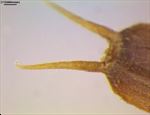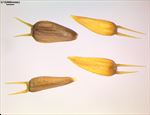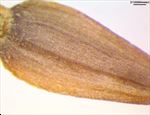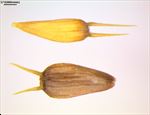Taxonomy
Calyptocarpus vialis Less., Syn. Gen. Compos. 221. 1832Common synonyms
Blainvillea tampicana (DC.) Benth. & Hook.f.; Blainvillea tampicana (DC.) Benth. & Hook.f. ex Hemsl.; Calyptocarpus blepharolepis B.L.Rob.; Calyptocarpus tampicanus (DC.) Small; Oligogyne tampicana DC.; Synedrella vialis (Less.) A.Gray; Zexmenia hispidula BuckleyCommon name
Creeping cinderella weed, horseherb, straggler daisy, lawnflower
Description
Propagule or dispersal unit is the fruit with pappus. Fertile part 2.8-4.2 mm long, 0.6-1.5 mm wide, in side view widest in upper part (obovoid), +/- straight, the upper (apical) end narrowing, in cross-section flattened or angular (prismatic), basal scar (carpopodium) pronounced and well-differentiated or inconspicuous and undifferentiated, central, beak (=thinner sterile stalk between seed and pappus) absent, wings absent, fruit surface light brown or straw, rarely black, smooth (except at cellular level), with simple straight hairs, rarely no hairs (glabrous), thickened margin absent or present, thick margin hairs simple straight hairs, longitudinal ribs absent.
Pappus type awns or spines, pappus elements all +/- similar, rarely clearly differentiated, up to 1-2.5 mm long, in one row, number of pappus elements two, rarely three to five, persistent, the individual awns smooth, +/- upright, rarely +/- divergent, +/- straight.
Ecology
Annual to short-lived perennia herb, fruits with a pappus of spines and thus presumably dispersed by sticking to fur and clothes. Subtropical regions. Found in rainforest margins, footpaths, roadsides, railroads and other open and disturbed areas, and sometimes in lawns.
Native range
Southern United States, Mexico, Central America and Caribbean
Introduced range
Hawai'i, Taiwan, Australia




